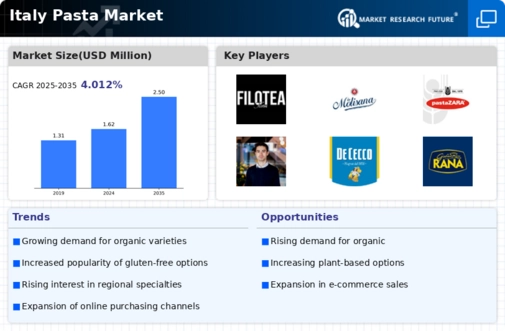Health and Wellness Trends
The pasta market in Italy is increasingly influenced by health and wellness trends, as consumers become more conscious of their dietary choices. There is a growing demand for whole grain and gluten-free pasta options, reflecting a shift towards healthier eating habits. Market Research Future suggests that sales of whole grain pasta have risen by approximately 15% in the last year, indicating a significant consumer preference for nutritious alternatives. Additionally, the rise of plant-based diets has prompted manufacturers to explore innovative ingredients, such as legume-based pasta, which offers higher protein content. This focus on health and wellness is reshaping product development within the pasta market, as brands strive to cater to the evolving preferences of health-conscious consumers. The integration of nutritional benefits into pasta products is likely to enhance their appeal and drive market growth in the coming years.
Culinary Heritage and Tradition
The pasta market in Italy is deeply rooted in the country's culinary heritage, which significantly influences consumer preferences. Traditional pasta dishes are integral to Italian culture, leading to a consistent demand for authentic products. This cultural attachment to pasta is reflected in the market, where approximately 80% of households consume pasta regularly. The emphasis on traditional recipes and regional variations fosters a strong connection between consumers and local producers. As a result, the pasta market thrives on the preservation of these culinary traditions, which not only sustains local economies but also enhances the overall appeal of pasta as a staple food. The enduring popularity of pasta dishes, such as spaghetti and lasagna, underscores the importance of culinary heritage in shaping consumer behavior and driving market growth.
Rising Demand for Convenience Foods
In recent years, the pasta market in Italy has experienced a notable shift towards convenience foods. Busy lifestyles and changing consumer habits have led to an increased preference for quick and easy meal solutions. Pre-packaged pasta products, including ready-to-cook and microwaveable options, have gained traction among consumers seeking time-saving alternatives. Market data indicates that the sales of convenience pasta products have surged by approximately 25% over the past two years. This trend is particularly evident among younger demographics, who prioritize convenience without compromising on taste. As a result, manufacturers are adapting their offerings to meet this demand, leading to innovations in packaging and product formats. The growing inclination towards convenience foods is likely to continue shaping the pasta market, as consumers seek efficient meal solutions that align with their fast-paced lifestyles.
Sustainability and Ethical Sourcing
Sustainability has emerged as a crucial driver in the pasta market in Italy, as consumers increasingly prioritize environmentally friendly products. There is a growing awareness of the impact of food production on the environment, leading to a demand for sustainably sourced ingredients and eco-friendly packaging. Market data suggests that approximately 40% of consumers are willing to pay a premium for pasta products that adhere to sustainable practices. This trend has prompted manufacturers to adopt ethical sourcing methods and implement sustainable production processes. The emphasis on sustainability not only aligns with consumer values but also enhances brand loyalty and trust. As the pasta market evolves, companies that prioritize sustainability are likely to resonate with environmentally conscious consumers, thereby driving growth and innovation in the sector.
E-commerce and Digital Transformation
The pasta market in Italy is witnessing a transformation driven by the rise of e-commerce and digital platforms. Online grocery shopping has gained popularity, particularly among younger consumers who prefer the convenience of purchasing food products online. This shift has prompted pasta manufacturers and retailers to enhance their online presence and invest in digital marketing strategies. Recent data indicates that online sales of pasta products have increased by approximately 30% in the past year, reflecting changing consumer shopping behaviors. The ability to reach a broader audience through e-commerce channels is likely to provide significant growth opportunities for the pasta market. As digital transformation continues to reshape the retail landscape, companies that effectively leverage online platforms may gain a competitive edge in the evolving market.

















Leave a Comment